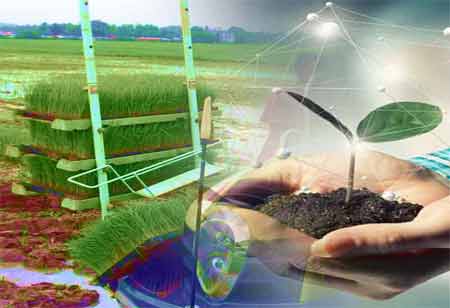Thank you for Subscribing to Agri Business Review Weekly Brief
Aquafarming for Beginners: Diving into Sustainable Seafood Production in Europe
Aquaculture, the controlled cultivation of fish, shellfish, and aquatic flora, is experiencing significant expansion within the European market.

By
Agri Business Review | Tuesday, March 12, 2024
Stay ahead of the industry with exclusive feature stories on the top companies, expert insights and the latest news delivered straight to your inbox. Subscribe today.
Aquaculture in Europe is expanding due to environmental concerns and demand. Compliance with EU regulations, infrastructure, knowledge, and funding are crucial. Future aquafarming prioritises innovation, sustainability, and ecosystem preservation.
FREMONT, CA: Aquaculture, the controlled cultivation of fish, shellfish, and aquatic flora, is experiencing significant expansion within the European market. Fueled by escalating demand for seafood and heightened environmental apprehensions regarding traditional fishing practices, aquaculture emerges as a pivotal sustainable solution for seafood provisioning.
Exploring Aquafarming Systems in Europe
The European aquafarming sector exhibits a rich diversity, featuring a range of systems tailored to different species and geographical conditions. Key methodologies include:
Marine Aquaculture: involves using offshore cages or pens to cultivate fish such as salmon, sea bass, and sea bream. Implementing this method demands substantial investment and specialised expertise to manage oceanic currents and weather fluctuations effectively.
Freshwater Aquaculture: This approach employs ponds, tanks, and raceways to cultivate freshwater species like carp and trout. Often situated on land, this system offers greater control over water quality parameters.
Recirculating Aquaculture Systems (RAS): These closed-loop systems, typically housed indoors, treat and recycle water, making them well-suited for urban environments and minimising environmental footprints. RAS facilitates the cultivation of diverse species, including those of high commercial value.
Integrated Multi-Trophic Aquaculture (IMTA): An innovative technique, IMTA integrates fish farming with other aquaculture sectors such as seaweed or shellfish cultivation. This approach fosters a harmonised ecosystem by utilising byproducts from one species as nutrients for another, promoting sustainability and efficiency in aquafarming practices.
Choosing the Species and Market
Researching market demand involves identifying species with high demand and favourable market potential within one's region. In Europe, popular choices include salmon, trout, mussels, and oysters. Additionally, individuals should assess their skills and available resources. Beginners may find freshwater fish farming more accessible due to more straightforward permitting procedures and lower initial investments than marine aquaculture. Moreover, aligning with sustainability practices is paramount, given Europe's growing consumer preference for sustainable seafood production. This entails exploring eco-friendly methods such as organic aquaculture and incorporating alternative feeds. Considering these factors, individuals can strategically position themselves within the aquaculture industry while promoting environmental responsibility and meeting market demands.
Regulatory Framework and Licensing
Before commencing aquafarming operations, it is imperative to navigate relevant regulations. The European Union (EU) presents a robust regulatory framework governing aquaculture, encapsulated within directives such as the EU Aquaculture and Fisheries Strategy and the Water Framework Directive. Compliance with these regulations is essential. Moreover, individual EU member states enforce supplementary regulations about permits, environmental assessments, and animal welfare. It is advisable to liaise with local authorities to obtain comprehensive guidance tailored to specific jurisdictional requirements.
Building Aquafarm Infrastructure
After devising a plan, the next step is to establish the necessary infrastructure for the farm. The location should be carefully selected, ensuring access to clean water, adequate infrastructure such as electricity and transportation, and proximity to markets for efficient distribution. Equipment requirements will vary based on the chosen system. Standard necessities include ponds or tanks, aeration systems, filtration units, and feeding systems. Specialised water treatment equipment is essential for recirculating aquaculture systems (RAS).
Knowledge and Training
Aquafarming demands a nuanced amalgamation of scientific expertise, business acumen, and hands-on proficiency. To facilitate this multifaceted preparation, several resources are available:
University Courses: Numerous European universities furnish comprehensive aquaculture programs tailored to impart a deep understanding of the field's intricacies.
Professional Associations: Engaging with esteemed organisations such as the European Aquaculture Society or national aquaculture associations offers invaluable networking avenues, training prospects, and a means to remain abreast of industry developments.
Government Resources: Many European governments extend support through extension services and specialised training initiatives to nurture aspiring aquafarmers, foster growth, and ensure sustainability within the industry.
Funding and Business Planning
Aquafarming emerges as a capital-intensive endeavour, necessitating strategic funding approaches. Government grants, including various EU and national initiatives, are pivotal pillars for fostering sustainable aquaculture growth. Furthermore, financial institutions such as banks and agricultural credit organisations extend loans tailored to aquaculture ventures. Private investors, mainly those interested in sustainable food production, present promising avenues for partnership and investment. It is imperative for aquafarming entrepreneurs to formulate a comprehensive business plan delineating production strategies, financial forecasts, marketing initiatives, and risk mitigation measures to enhance credibility and attract potential investors and lenders.
The Future of European Aquafarming
The European aquafarming sector is experiencing significant growth, propelled by a commitment to innovation and sustainability. To flourish, conducting comprehensive research, complying with regulatory standards, and maintaining a continuous learning mindset are essential. Additionally, embracing technological advancements like automation, considerable data utilisation, and precision aquaculture can enhance production efficiency. Prioritising environmental sustainability through waste reduction, sustainable feed usage, and ecosystem preservation is crucial. Furthermore, recognising evolving consumer preferences for ethically and environmentally responsible seafood sourcing and highlighting such commitments can bolster market presence and reputation.





